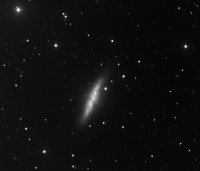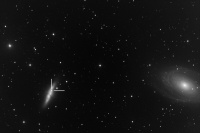Difference between revisions of "Astrophotography"
| Line 5: | Line 5: | ||
Currently, I am building out my [http://www.tedvlango.com/astrophotography portfolio of images]. | Currently, I am building out my [http://www.tedvlango.com/astrophotography portfolio of images]. | ||
| − | I am also shooting the entire [Messier Catalog] - with about 60% complete! | + | I am also shooting the entire [[Messier Catalog]] - with about 60% complete! |
Here a few samples. Visit the link above for more! | Here a few samples. Visit the link above for more! | ||
Revision as of 08:22, 29 April 2014
Wikipedia describes Astrophotography as "a specialized type of photography that entails recording images of astronomical objects and large areas of the night sky. The first photograph of an astronomical object (the Moon) was taken in 1840, but it was not until the late 19th century that advances in technology allowed for detailed stellar photography. Besides being able to record the details of extended objects such as the Moon, Sun, and Planets, astrophotography has the ability to image objects invisible to the human eye such as dim stars, nebulae, and galaxies]. This is done by long time exposure since both film and digital cameras can accumulate and sum light photons over these long periods of time. In professional astronomical research, photography revolutionized the field, with long time exposures recording hundreds of thousands of new stars and nebulae that were invisible to the human eye, leading to specialized and ever larger optical telescopes that were essentially big "cameras" designed to collect light to be recorded on film. Direct astrophotography had an early role in sky surveys and star classification but over time it has given way to more sophisticated equipment and techniques designed for specific fields of scientific research, with film (and later CCD cameras) becoming just one of many forms of sensor."
I personally conduct most of my astrophotography by leveraging the telescopes available to me via iTelescop.net. I started taking my first pictures using my own telescope in my teens, but as my professional career had me move over different parts of the country, it became difficult to impractical to continue shooting direct. In addition, the proper mounts and camera equipment can be very costly, and the trade-off of leveraging an IP based array of telescopes allows me the capability of shooting far more objects throughout the year.
Currently, I am building out my portfolio of images.
I am also shooting the entire Messier Catalog - with about 60% complete!
Here a few samples. Visit the link above for more!
Messier 82
Messier 82 (also known as NGC 3034, Cigar Galaxy or M82) is a "remarkable galaxy of peculiar type in constellation Ursa Major. It is usually classified as irregular, though probably a distorted disk galaxy, and famous for its heavy star-forming activity, thus a prototype member of the class of starbursting galaxies." [1]
SN 2014J, a Type Ia supernova, was observed in the galaxy on 21 January 2014. I photographed this supernova on January 29th, 2014, shortly after it was discovered.

